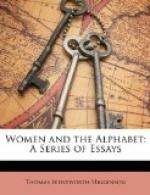We find, on investigation, what these considerations would lead us to expect, that eminent women have commonly been exceptional in training and position, as well as in their genius. They have excelled the average of their own sex because they have shared the ordinary advantages of the other sex. Take any department of learning or skill; take, for instance, the knowledge of languages, the universal alphabet, philology. On the great stairway at Padua stands the statue of Elena Cornaro, professor of six languages in that once renowned university. But Elena Cornaro was educated like a boy, by her father. On the great door of the University of Bologna is inscribed the epitaph of Clotilda Tambroni, the honored correspondent of Porson, and the first Greek scholar of southern Europe in her day. But Clotilda Tambroni was educated like a boy, by Emanuele Aponte. How fine are those prefatory words, “by a Right Reverend Prelate,” to that pioneer book in Anglo-Saxon lore, Elizabeth Elstob’s grammar: “Our earthly possessions are indeed our patrimony, as derived to us by the industry of our fathers; but the language in which we speak is our mother tongue, and who so proper to play the critic in this as the females?” Yet this particular female obtained the rudiments of her rare education from her mother, before she was eight years old, in spite of much opposition from her right reverend guardians. Adelung declares that all modern philology is founded on the translation of a Russian vocabulary into two hundred different dialects by Catherine II. But Catherine shared, in childhood, the instructors of her brother, Prince Frederick, and was subject to some reproach for learning, though a girl, so much more rapidly than he did. Christina of Sweden ironically reproved Madame Dacier for her translation of Callimachus: “Such a pretty girl as you are, are you not ashamed to be so learned?” But Madame Dacier acquired Greek by contriving to do her embroidery in the room where her father was teaching her stupid brother; and her queenly critic had herself learned to read Thucydides, harder Greek than Callimachus, before she was fourteen. And so down to our own day, who knows how many mute, inglorious Minervas may have perished unenlightened, while Margaret Fuller Ossoli and Elizabeth Barrett Browning were being educated “like boys.”




